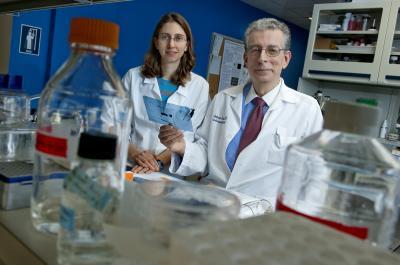PROVIDENCE, R.I. – Researchers in Rhode Island Hospital's Cardiovascular Research Center have published two new studies focusing on the causes of arrhythmia and sudden cardiac death (SCD) when a genetic disorder is present. The studies use a first-ever genetic animal model the researchers developed in 2008 to further their understanding of a genetic disorder known as Long QT Syndrome (LQTS). The first study identified differential conditions and cellular mechanisms that can trigger SCD when LQTS is a factor, and the second study, for the first time, directly links sex hormones and the incidence of arrhythmia and SCD. Their findings are published in the Journal of Physiology and the HeartRhythm Journal.
It is known that genetic mutations can predispose individuals to arrhythmia and/or SCD, a leading cause of death in the United States. Between one in 2,500 and one in 5,000 individuals are born with mutations that cause LQTS, a disorder of the heart's electric system, and a determining factor in the development of arrhythmia and/or SCD. Ninety percent of the known mutations cause loss of function of ion channels responsible for LQTS types 1 and 2 (LQT1 and LQT2).
LQTS leads to a prolonged "QT interval" on electrocardiograms. The QT interval refers to the time it takes the chambers of the heart to "repolarize" themselves so that the heart is ready for another contraction cycle. When this timeframe is lengthened, it is associated with triggering irregular arrhythmia that can cause sudden cardiac arrest.
In 2008, Gideon Koren, M.D., a physician researcher and director of the Cardiovascular Research Center at Rhode Island Hospital, and his colleagues developed a first-of-its-kind genetic rabbit model to study arrhythmia and SCD that mirrors what happens in individuals who have mutations of the LQT1 or LQT2 genes.
In a new study published in the Journal of Physiology, the researchers used this animal model to identify differential conditions and cellular mechanisms that trigger arrhythmia in LQT1 or in LQT2 syndrome. In this study, Koren and the researchers studied early afterdepolarizations (EADs), an abnormal depolarization during the plateau phase of the heart electrical activity (action potential) that can initiate arrhythmia, and a hallmark of LQTS. The focus was on mechanisms underlying different high-risk conditions that trigger EADs.
Their findings indicate that the conditions required for EAD to occur in the animal models are genotype specific. For LQT2, the researchers found that conditions such as a slow heart rate or a slightly lower potassium ion concentration outside the heart cells (as seen in hypokalemia) can cause a dramatic prolongation of action potential and produce triggered activity (EADs). In LQT1, however, these conditions result in relatively limited prolongation and no EADs. In contrast, isoproterenol that mimics cardiac stimulation by the sympathetic system causes arrhythmias in single cells only in LQT1 heart cells.
Koren summarizes, "This study takes single cells out of the heart and reveals how arrhythmias are being initiated. What we are showing in this study is that single cells are responsible for generating an arrhythmia. Further, we found that different types of increased autonomic nervous system activity play a critical role in the cause of arrhythmias and sudden cardiac death, but it differs based on genotype."

Gideon Koren, M.D., director of the Rhode Island Hospital Cardiovascular Research Center is the lead author of two newly published studies that shed light on sudden cardiac death when a genetic condition known as Long QT syndrome is present. The study is the first to directly link SCD with the sex hormones in a first-of-its-kind animal model.
(Photo Credit: Rhode Island Hospital)
The autonomic nervous system is what controls "fight or flight" response. In their research, Koren and his colleagues found that sympathetic "surge" activity was responsible for triggering arrhythmia in LQT2. In LQT1, however, an increased steady sympathetic tone was associated with arrhythmias.
Surge is a sudden rise of the sympathetic tone. That surge is very important in triggering arrhythmia in LQT2. As Koren explains, "In LQT2, you need the startle response -- like an alarm clock. However, in LQT1, we found the increased steady sympathetic tone is very important in inducing arrhythmia, like in patients swimming for an extended period of time. So there are different ways that arrhythmia will be induced depending on the genotype."
In a second study, published in the HeartRhythm Journal, Koren and his colleagues furthered their understanding of arrhythmias by studying the impact of sex hormones, and confirming for the first time a direct link between the hormones and SCD.
Koren explains, "Quite simply, we demonstrate that estrogen promotes major cardiac events – such as polymorphic ventricular tachycardia (pVT) and SCD – while progesterone prevents them when LQT2 is a factor. Estrogen has a pro-arrhythmic effect."
Sex differences in long-QT-related arrhythmias with a higher risk of pVT and SCD have been well-documented in the clinical setting, and the risk is higher in women than in men, particularly during the postpartum period. In this study, Koren says, "We show for the first time a direct link between sex hormones and the incidence of arrhythmias and sudden cardiac death. Through our research in our animal models, we have demonstrated that progesterone significantly reduces triggers for polymorphic ventricular tachycardia. At the same time, we were able to show that progesterone is protective and prevents SCD when LQT2 is present."
Koren explains that this finding suggests that high progesterone levels during pregnancy likely account for the reduced risk of SCD in LQT2 patients during pregnancy. The marked reduction in progesterone during the postpartum period, however, likely promotes arrhythmias and SCD in these patients. Their findings also indicate that estrogen increases both trigger and sustainability of pVT, and thereby promotes major cardiac events.
He concludes that while further studies are needed in clinical trials, the clinical implications of this study will impact on the standard treatment of patients who are diagnosed with LQT2. Specific hormone-based therapies may be prescribed to protect them from arrhythmia and potentially avoid sudden cardiac death.
Source: Lifespan